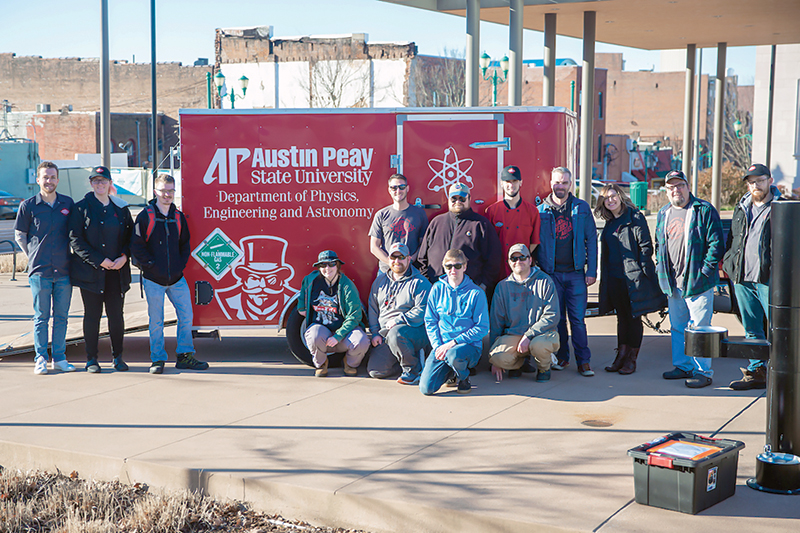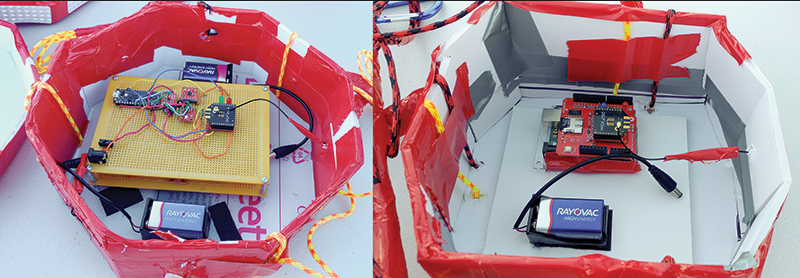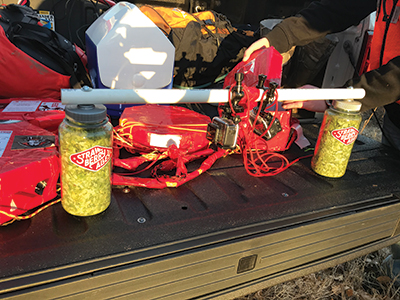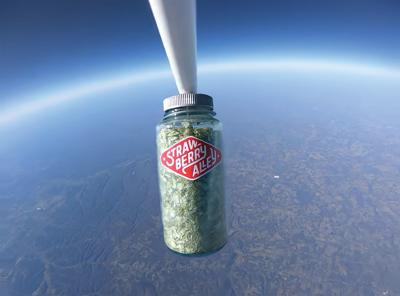Beer from the Stratosphere: A Payload with a Tasty Payoff
Spring
2020
Building Blocks - Undergraduate Research and Outreach Projects
Beer from the Stratosphere: A Payload with a Tasty Payoff
Zachary Hill, SPS Chapter President, Dr. Justin Oelgoetz, Faculty Advisor, Bryan Gaither, Lab Manager, and Ivy MacDaniel, SPS Member, Austin Peay State University
 When the High-Altitude Balloon Project was born at Austin Peay State University in Clarksville, Tennessee, several years ago, our group’s intent was to explore the Earth’s upper atmosphere. With our most recent launch, we also contributed to a local brewery’s creation of a special batch of ale—the appropriately named Stratospheric Black.
When the High-Altitude Balloon Project was born at Austin Peay State University in Clarksville, Tennessee, several years ago, our group’s intent was to explore the Earth’s upper atmosphere. With our most recent launch, we also contributed to a local brewery’s creation of a special batch of ale—the appropriately named Stratospheric Black.
This particular project involved developing a wireless communication network that can be used to sync data across payloads during flight. On January 8, 2020, we launched both a proof-of-concept technical payload (demonstrating wireless communication between payload packages) and hops provided by Strawberry Alley Ale Works—a restaurant and brewery a few blocks from campus.
Bryan Gaither, the laboratory manager for APSU’s Department of Physics, Engineering, and Astronomy, dreamed up the idea for this collaboration.
“We [at APSU] are always looking for opportunities to do exciting events with and for our local community,” he says. “One of my favorite local restaurants and breweries is Strawberry Alley Ale Works, located in historic downtown Clarksville, about a mile from campus. We have already partnered with them to host our monthly Science on Tap, where we have different faculty members present current and relevant scientific topics while enjoying lovely libations.”
Ivy MacDaniel, an APSU physics major and member of our local SPS chapter, became involved with the balloon project because she “was mainly focused on weather research and . . . wanted a little hands-on [experience] in a very similar project.” She started out just chasing the balloon but has “started monitoring projections, winds, and weather forecasts about a week [out] . . . [helping to] make plans for the launch, which includes calling airports if necessary.” For this launch, Ivy did the projections for the path the balloon would take and told us that it looked to be going very close to the Nashville airport. As a result, we had to call up the airport and let them know when we were planning to launch and how close it would be.
Launching the Payload and Recovery
The January payload consisted of three major parts: the wireless communication network, the hops, and the tracking equipment. The wireless communication network included two payload boxes—one with a radio module and all the sensors (pressure, acceleration, temperature) and one with a radio module and an Arduino to receive and record the data from the sensors.
We filled the balloon and attached the payload using our standard procedure,1 launching the balloon at around 8:30 a.m. The balloon and payload were tracked using an iridium-based system developed for the Eclipse Ballooning Project, led by the Montana Space Grant Consortium.2 The balloon remained aloft for about two hours, reaching an altitude of over 95,000 feet (video from that altitude is available).3 After the balloon popped, the payload began its descent and came to rest in a tree outside of Carthage, Tennessee, about 80 miles away.
“As we hiked out to the final GPS coordinates, deep into the woods on the side of a mountain, I started to get a sinking feeling in my stomach and just knew that I was about to spend a painful amount of time in a tree to recover this special payload,” Gaither says. “It turns out that the payload parachuted to the top of a tree, approximately 70 feet off the ground. I unpacked my gear, shot a line into the tree with my modified crossbow, secured the climbing rope, and began to ascend the tree. We were fighting daylight hard and my hands were cramping. I got all the way up to as high as my gear would let me go, and then I pulled up this 16-foot pole saw, and for an hour and a half I worked at it.”
After freeing the balloon from the tree, we returned with the payload. The technical part of the payload, the wireless communication system, worked mostly as designed. It did turn off prematurely, a failure we are still investigating. Perhaps most importantly to Gaither, we returned the hops to Strawberry Alley Ale Works.
“I can’t wait to sample their new Stratospheric Black IPA,” he says. The keg-tapping party is scheduled for March 31.
We are looking forward to more launches and collaborations, including an upcoming flight coordinated with an area middle school. There’s not likely to be any beer-related payloads on that flight, but it’s sure to be a great time anyway.




References
1. Megan McCracken et al., “High Altitude Ballooning Using Amateur Equipment: A Primer,” in Celebrating the 2017 Great American Eclipse: Lessons Learned from the Path of Totality, eds. Sanlyn R. Buxner, Linda Shore, and Joseph B. Jensen, ASP Conference Series Vol. 516 (San Francisco, CA: Astronomical Society of the Pacific, 2019), 491, www.aspbooks.org/a/volumes/article_details/?paper_id=38799.
2. Angela C. Des Jardins et al., “Eclipse Ballooning Project Live Streaming Activity: Overview, Outcomes, and Lessons Learned,” in Celebrating the 2017 Great American Eclipse: Lessons Learned from the Path of Totality, eds. Sanlyn R. Buxner, Linda Shore, and Joseph B. Jensen, ASP Conference Series Vol. 516 (San Francisco, CA: Astronomical Society of the Pacific, 2019), 353, www.aspbooks.org/a/volumes/article_details/?paper_id=38794.
3. Footage of the hops when the balloon popped at the peak of the flight can be seen at www.youtube.com/watch?v=2vtkFKufT64/.
More from this department
Building Blocks - Undergraduate Research and Outreach Projects
